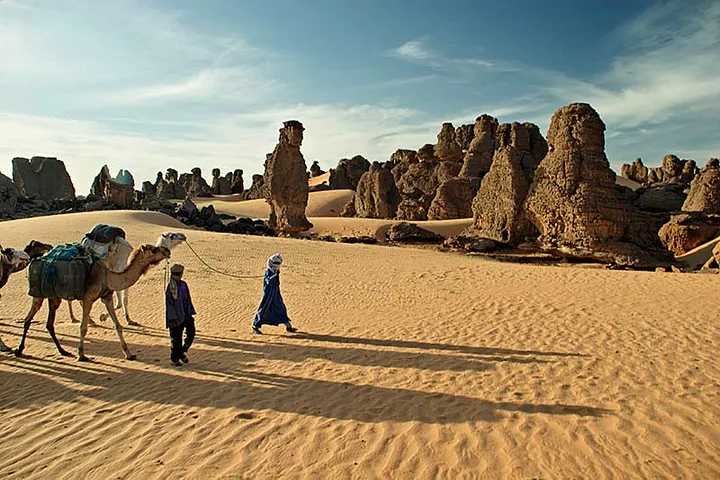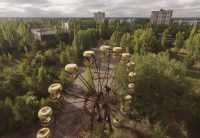The Strangest Cities in the World that Exist
There are many strange places around the world, around which numerous stories have been woven and many legends revolve. In our contemporary time, there are many cities that are still surrounded by much mystery or unexplained strange events despite the advancements. Many have not been able to uncover the secrets of these places, and even if they have in some cases, they remain a mystery and unique places in their own right.
Derinkuyu : Jinn city, Turkey

The city of the jinn in Turkey, known as “Derinkuyu,” is one of the most famous and mysterious underground cities in the world. This city is located in the Cappadocia region and dates back to ancient times, believed to have been built in the 7th and 8th centuries BC.
Features of Derinkuyu:
Depth and Expansion: The city extends to a depth of about 60 meters underground and consists of 18 floors. It is believed that this city could house up to 20,000 people along with their livestock and food supplies.

Architecture: The city contains an integrated system of tunnels, rooms, churches, storerooms, kitchens, places of worship, and schools. The tunnels were designed to prevent enemy entry and allow for quick escapes.
Ventilation and Water: Derinkuyu includes an advanced ventilation system and natural water sources to ensure the inhabitants’ survival for extended periods underground.


Defensive Purposes: The city was built as a refuge for the inhabitants to protect them from invaders and wars. The doors were made of stone and could be closed from the inside to prevent enemies from entering.
Discovery: The city was discovered by chance in 1963 when a local resident was renovating his house and found an entrance leading to the extensive network of underground tunnels.

Tourism:
Today, Derinkuyu is one of the major tourist attractions in Turkey, with visitors from all over the world coming to explore this unique archaeological site and learn about the ancient history and remarkable engineering used in its construction.
Sefar City, Algeria

The lost city of Sifar is the largest fossilized city in the world, the oldest of the pyramids of Egypt, it may even be the cradle of humanity according to archaeologists, this city full of legends and myths is today prohibited, it is one of Algeria’s famous archaeological sites, located in the Tassili n’Ajjer region in the southeastern part of the country, within the Illizi Province. It is considered one of the greatest and most enigmatic desert cities in the world. it is home to one of the largest troglodytic cities not only in Algeria but in the world.
It contains more than five thousand cave houses and more than 15 thousand murals and inscriptions dating back more than 20 thousand years.


Historical Background:
Sefar, part of the Tassili n’Ajjer region, was home to an ancient culture dating back to the Neolithic period, around 6000 to 2000 BCE. The rock art and engravings found in the area reflect the lives of people from that era, including scenes of hunting, dancing, religious rituals, and daily life.
Features of Sefar:
Rock Art: Sefar is renowned for having the largest collection of prehistoric rock paintings and engravings in the world. These artworks depict both human and animal life from that period.
The Stone City: Sefar is known as the “Stone City” due to its natural rock formations that resemble buildings and houses, giving the impression of an ancient city made entirely of stone.
Legends and Mystery: Sefar is surrounded by numerous legends and mysterious stories. Some consider it to be a city of jinn, due to its unique rock formations and enigmatic atmosphere.

Geographical Location: Located in a remote area of the Sahara Desert, reaching Sefar can be challenging. However, this isolation has helped preserve the rock art and engravings. The environment in Sefar is dry and desert-like, which makes life difficult, but it offers breathtaking natural scenery and intriguing rock formations.
Exploration and Preservation:
Exploration: Sefar has attracted many archaeologists and researchers who have come to study the rock art and engravings. These studies have contributed to our understanding of ancient civilizations.
Preservation: Given Sefar’s historical importance, Algerian authorities are working to protect and preserve these sites from erosion and destruction. Sefar has been part of the UNESCO World Heritage List since 1982, recognizing its cultural and historical significance.


Tourism in Sefar:
Due to its historical and archaeological importance, Sefar is a significant tourist destination, especially for history and archaeology enthusiasts. Visitors embark on exploratory trips to view the rock paintings and unique rock structures, making Sefar a distinctive and exceptional place in the world.
Sefar is considered an open-air museum that showcases the history of humanity in prehistoric times. It is well worth visiting to uncover its secrets and enjoy its natural and mysterious beauty.
Colma city, united states of america

This small city is known as the “City of the Dead” as the number of graves exceeds the number of living residents. Colma, located in California, USA, is a small city distinguished by its unique characteristics due to its history and location. Here is some key information about it:
Founding: Colma was established in 1924. The city earned its nickname “City of the Dead” due to the decision made by local authorities in the early 20th century to relocate cemeteries and the deceased from San Francisco to Colma to accommodate urban expansion.
San Franciso passed a law declaring no more burials were permitted in city limits because the land was just too valuable to give up to the dead. But the city went even further to protect its real estate. In January of 1914, eviction notices were sent out to all cemeteries in San Franciso to remove all the bodies and monuments. Little Colma suddenly inherited hundreds of thousands of bodies.
Distinctive Features:
Number of Graves: Colma is known for having one of the highest numbers of graves relative to its living population. It is estimated that there are over 1.5 million graves in the city, while the living population is around 1,500.


Cemeteries: The city houses a large number of cemeteries and religious facilities dedicated to the burial of the dead. There are approximately 17 major cemeteries in Colma, including Menlo Park, Presbyterian, and San Francisco National.
Purpose: Colma was specifically created to address the issue of insufficient burial land in San Francisco. The presence of cemeteries has become a defining feature of the city’s identity.
Economy and Infrastructure:
Economy: The city heavily relies on income from its cemeteries and related services. This industry is the primary source of revenue, with fees collected for funeral services and maintenance.
Public Services: Colma provides essential services to its residents, including schools and health facilities, but it remains a small city in terms of size and economic activity compared to larger cities.

Culture and Community:
Peace and Tranquility: Colma is known for its tranquil and livable atmosphere, despite being a city filled with cemeteries. A small population enjoys the peace and cleanliness of the environment.
Events: The city participates in some special events and cultural occasions, reflecting its unique history and role as a quiet residential area in the San Francisco Bay Area.
Colma is an example of how cities adapt to unique challenges and has a distinctive character set apart from other cities due to its unique history and specialization in burial services.
Coober Pedy, Australia

Coober Pedy is a small town located in South Australia and is considered one of the most unique towns in the world due to its environmental conditions and the way its residents live. It is one of the most unique cities in the world, where its residents live in underground houses, with only scattered chimneys visible above the surface. Although it may appear lifeless due to the lack of activities above ground, approximately 3,500 people live beneath its surface. Here is some key information about Coober Pedy:
Historical Background:
Founding: Coober Pedy was established in the early 20th century following the discovery of opals in the region, which attracted miners and traders to the area.
Geographical Location:
Region: Coober Pedy is situated in the Great Australian Desert, approximately 846 kilometers north of Adelaide. It is a dry and arid region, where temperatures can become extremely high during the summer.


Unique Features:
Underground Homes: One of the notable features of Coober Pedy is its underground homes, known as “dugouts.” Due to the extreme heat and harsh conditions, residents have dug their homes underground to avoid the heat and keep the interiors cool. These homes are an effective alternative for living in the desert environment.
It has 1,500 residences, two churches, hotels, and shops that can be accessed through entrances above ground.
Opals: Coober Pedy is renowned as one of the world’s largest producers of opals. The town is a major center for opal mining, with numerous opal mines in the area.


Tourism:
Activities: Visitors can explore the underground homes, visit opal-themed museums, and enjoy tours of old mines. There are also tourist attractions such as the “Catacombs” and the “Coober Pedy Opal Mine” that showcase the town’s history and the opal industry.
Heritage: The town is known for its unique cultural heritage, with residents from diverse backgrounds, including Indigenous Australians and immigrants from various countries.
Infrastructure and Services:
Services: Coober Pedy has all essential services such as schools, hospitals, and shops. Despite its small size, the town provides a comfortable environment for both residents and visitors.
Transportation: Coober Pedy can be accessed via flights from Adelaide or by road from other major cities.


Culture and Community:
Daily Life: Life in Coober Pedy is significantly different from that in major cities due to the environmental conditions and the unique design of the homes. The local community is close-knit and well-connected.
Coober Pedy is an example of how people adapt to harsh environments and natural challenges, offering visitors a unique experience due to its distinctive history and unconventional living conditions.














Leave a comment